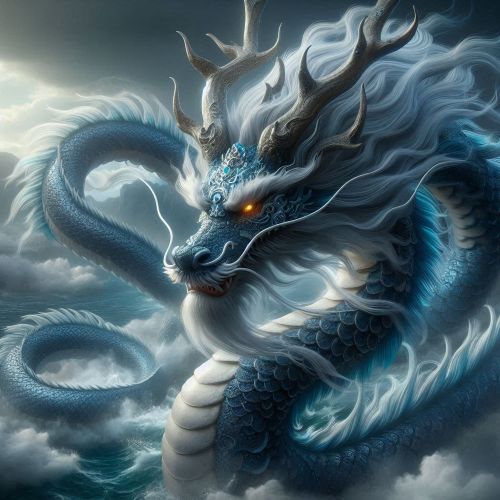Ao Qin : The Dragon King of the Southern Seas
Listen
At a glance
| Description | |
|---|---|
| Origin | Chinese Mythology |
| Classification | Animals |
| Family Members | Ao Guang, Ao Run, Ao Shun (Brothers) |
| Region | China |
| Associated With | Southern Seas |
Ao Qin
Introduction
Ao Qin (敖欽), the Dragon King of the South Sea, holds a vital place in Chinese mythology as one of the Four Dragon Kings who govern the cardinal seas—East, West, North, and South. These divine rulers are embodiments of the cosmic order, representing the balance of natural forces and the connection between heaven, earth, and the watery depths. Ao Qin’s dominion over the southern seas links him to warmth, vitality, and the fire element in Chinese cosmology, complementing the southern direction’s association with summer. His myth highlights the ancient Chinese understanding of the sea not only as a source of sustenance but also as a realm of divine power, where deities maintained harmony between humanity and nature.
Ao Qin’s legend has deep roots in both Daoist and Buddhist traditions, blending cosmological symbolism with moral teachings. He is venerated as both a protector of sailors and fishermen and a dispenser of justice who governs the ocean’s temper. Through temple worship, local festivals, and literary depictions, Ao Qin remains a revered guardian spirit whose influence extends across Chinese cultural and religious life.
Physical Traits
Ao Qin’s appearance is as majestic as the ocean he commands. He is typically portrayed as a great dragon with a long, sinuous body covered in iridescent scales that shimmer in shades of red, gold, or deep blue. His horns resemble those of a deer, and his whiskers flow like waves, symbolizing both wisdom and movement. When he appears in human form, Ao Qin is described as a dignified figure clad in imperial robes, his countenance calm yet commanding, radiating authority befitting a king of divine waters.
Artistic depictions in temples and murals often emphasize his dual nature—both benevolent and formidable. His dragon form embodies strength and vitality, capable of summoning storms or parting the waves, while his human visage reflects restraint and wisdom. In some interpretations, the red hue of his scales represents the fiery energy of the South, suggesting that even within the element of water, Ao Qin channels the transformative force of heat and creation.
Family
Ao Qin belongs to the divine fraternity of the Four Dragon Kings, each ruling one of the seas surrounding China. His brothers include Ao Guang of the East Sea, Ao Run of the West Sea, and Ao Shun of the North Sea. Together, they serve under the Jade Emperor, the supreme deity in Daoist cosmology, carrying out celestial commands related to rainfall, tides, and maritime order. This brotherhood represents not only the unity of the seas but also the balance of the natural elements that sustain life on earth.
In some folk legends, Ao Qin is said to have sons and daughters who act as minor sea spirits or guardians of specific coastal regions. A few tales also connect him indirectly to the dragon prince Ao Bing, who appears in the legend of Nezha. Whether through mythic kinship or divine duty, Ao Qin’s family embodies the interconnected hierarchy of deities responsible for maintaining balance across the world’s waters.
Other names
Ao Qin is known by several titles that reflect both his regional worship and mythological prominence. He is often referred to as the South Sea Dragon King (南海龙王), a name frequently inscribed on temple altars dedicated to him. Other names, such as Longwang (龙王, meaning “Dragon King”), are used more broadly to refer to him during prayers for rain or maritime safety. In older transliterations, particularly from Western sources, his name appears as Ao Ch’in or Aoqin.
These variations illustrate how Ao Qin’s legend has evolved across linguistic and cultural contexts. While he is primarily worshipped in southern China and along the coastal provinces like Guangdong, Hainan, and Fujian, his identity as a southern guardian has extended into broader Chinese folklore, where he symbolizes strength, loyalty, and divine protection.
Powers and Abilities
Ao Qin wields immense power over the sea and sky, governing tides, currents, and weather. His dominion includes the ability to summon rain and wind, calm tempests, and control the flow of the southern ocean. Fishermen and farmers often invoked him through rituals seeking his favor—asking for rain during droughts, calm waters during voyages, and abundant fish during harvest seasons.
Among his most celebrated abilities is his control over storms. Legends tell of Ao Qin summoning lightning and thunder to punish arrogant sailors or greedy rulers who disrespect the ocean’s sanctity. Conversely, he rewards humility, reverence, and ritual offerings, demonstrating his moral duality as both protector and punisher.
Ao Qin can also assume human form to communicate with mortals or test their virtue. This shape-shifting aspect aligns with the broader dragon archetype in Chinese mythology, symbolizing transformation, adaptability, and divine mediation. In spiritual terms, he acts as an intermediary between heaven and earth, transmitting celestial will through the language of natural forces—rainfall, tides, and wind.
Modern Day Influence
Ao Qin’s myth continues to resonate in modern Chinese culture, particularly in coastal regions where his name and image are deeply embedded in local traditions. Temples devoted to the Dragon Kings often feature shrines dedicated specifically to Ao Qin, where rituals are conducted to pray for favorable weather, maritime safety, and ecological balance. Annual ceremonies during the Dragon Boat Festival, for example, include offerings to Ao Qin and his brothers, acknowledging their enduring guardianship over the seas.
In literature and art, Ao Qin frequently appears as a symbol of moral order and elemental power. Classical novels such as Journey to the West and The Investiture of the Gods feature the Dragon Kings as celestial rulers who interact with both gods and mortals. In modern media—animated series, fantasy novels, and video games—Ao Qin is reimagined as a powerful water deity or dragon warrior, embodying both traditional reverence and contemporary heroism.
Academically, Ao Qin represents an important study in Chinese religious syncretism, where Daoist cosmology, folk belief, and local cults merge into a dynamic spiritual framework. His worship highlights how environmental dependence shaped divine hierarchies—especially in agrarian and maritime societies. More recently, environmental activists and cultural historians have drawn on Ao Qin’s symbolism to promote ocean conservation and sustainable fishing practices, invoking his ancient role as protector of the seas.
Today, Ao Qin stands not merely as a figure from ancient myth but as a continuing emblem of ecological harmony and respect for nature’s forces. His story bridges past and present, myth and reality, reminding humanity that reverence for the natural world is both a spiritual and practical duty.
Related Images
Source
Dragon University. (2023). The Nine Sons of the Dragon: Exploring Chinese Mythology. https://dragon.university/the-nine-sons-of-the-dragon-exploring-chinese-mythology/
Kuiken, C. J. (2011). The other Neng. University of Groningen. https://research.rug.nl/files/33172267/KuikenCJ-TheOtherNeng-herzien2011.pdf
Natalia Surii. (2024). The Legend of the Four Dragon Kings. https://www.nataliasuri.com/the-legend-of-the-four-dragon-kings-guardians-of-chinas-rivers/
Science.gov. (2018). Qin Terracotta Warriors. https://science.gov/topic/qin+terracotta+warriors
God Checker. (2023). AO QIN – Chinese Mythology. https://www.godchecker.com/chinese-mythology/AO-QIN/
L. University. (n.d.). Content Downloaded from HeinOnline Citations. https://www.luc.edu/media/lucedu/law/pdfs/ilr_18-2.pdf
Wikipedia. (2025). Dragon King. https://en.wikipedia.org/wiki/Dragon_King
PMC.ncbi.nlm.nih.gov. (2016). Admixture into and within sub-Saharan Africa. https://pmc.ncbi.nlm.nih.gov/articles/PMC4915815/
Yang, L. (2005). Handbook of Chinese Mythology. Oxford University Press.
Birrell, A. (1999). Chinese Mythology: An Introduction. Johns Hopkins University Press.
Wu, C. (2012). The Four Dragon Kings and Their Role in Taoist Cosmology. Journal of Chinese Religious Studies, 45(2), 123–138.
Teiser, S. F. (1996). The Ghost Festival in Medieval China. Princeton University Press.
Lagerwey, J. (2010). China: A Religious State. University of Hong Kong Press.
Frequently Asked Questions
Who is Ao Qin in Chinese mythology?
Ao Qin is the Dragon King of the Southern Sea and one of the four Dragon Kings who control the waters and weather of the world.
What does Ao Qin represent?
He symbolizes the South, summer, and the powerful monsoon rains that bring life and sometimes destruction.
Is Ao Qin related to other Dragon Kings?
Yes. He is one of four Dragon King brothers, including Ao Guang (East), Ao Run (West), and Ao Shun (North).
Where does Ao Qin rule?
His domain is the Southern Sea, often associated with warmer oceans and regions linked to maritime trade and tropical storms.
Does Ao Qin appear in popular stories or media?
Ao Qin appears in folklore connected to the sea palaces and sometimes features in adaptations involving dragons, storms, and ocean kingdoms.










